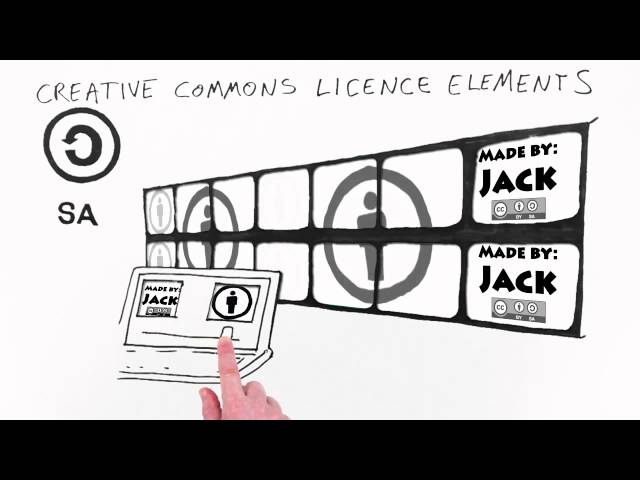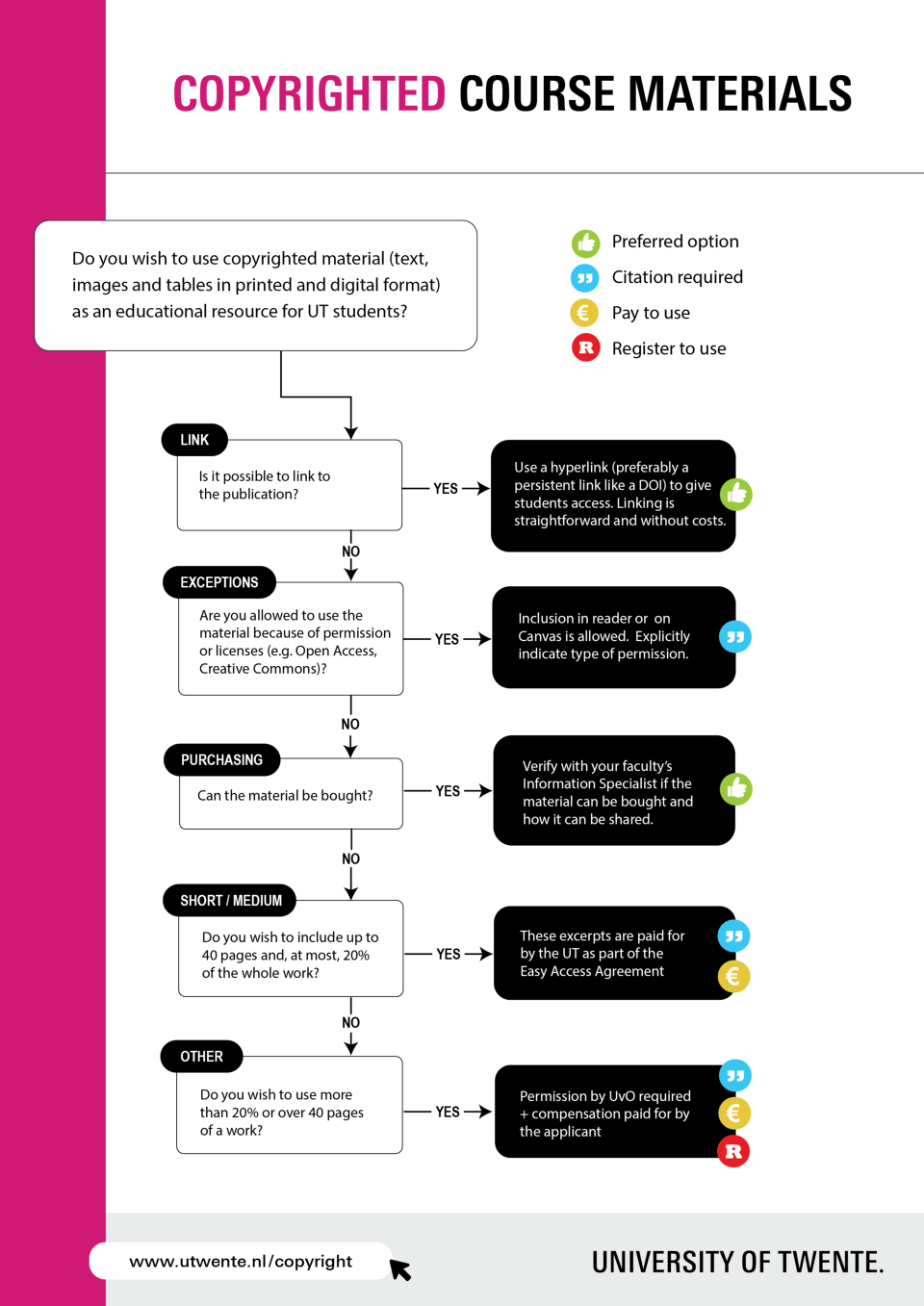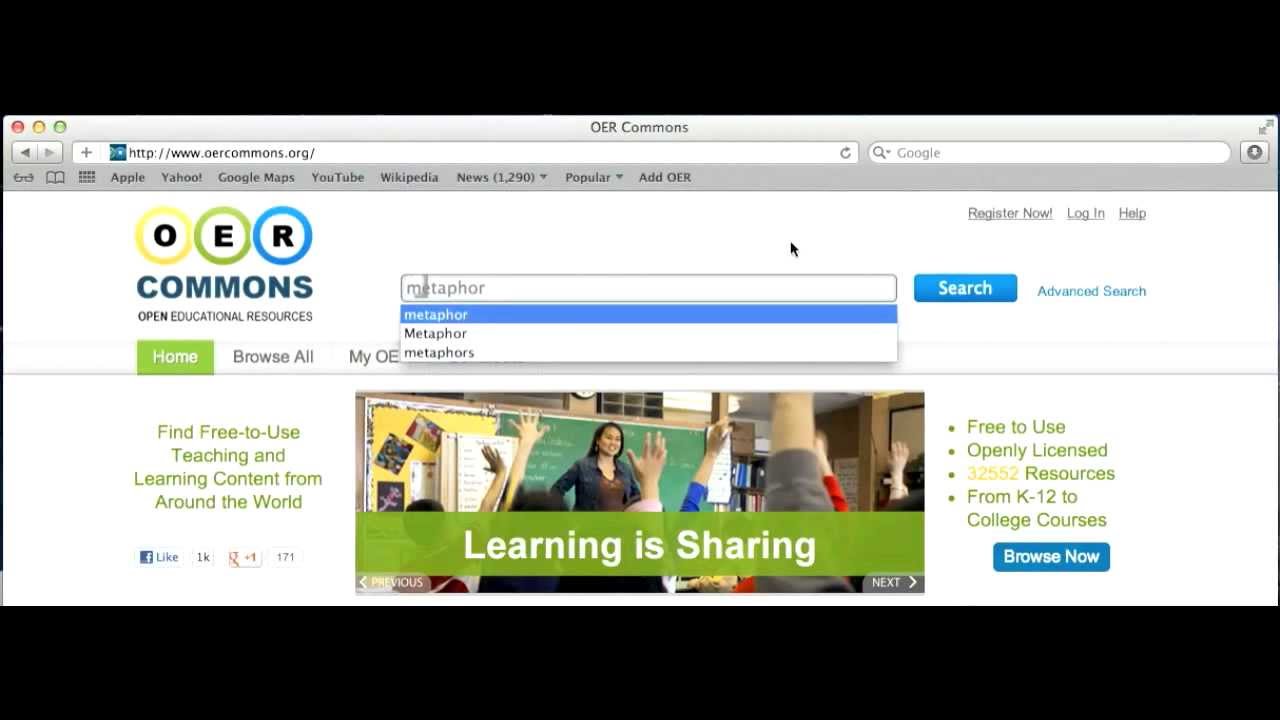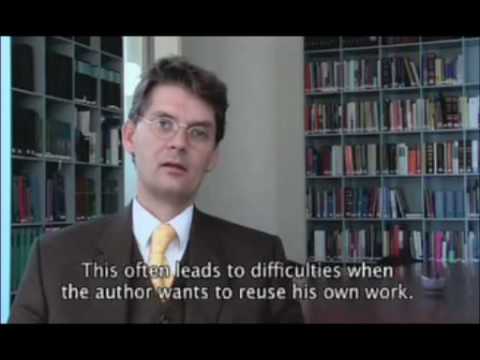As a University of Twente researcher, teacher or student, you will inevitably have to deal with copyrights. You might be infringing copyrights of other people’s work or transferring copyrights of your own without realizing it, so carefully read the information below.
- What is copyright?
Copyrights consist of moral rights and exploitation rights. Moral rights inseparably belong to the creator of a work, who should always get acknowledged when someone else uses the work, and who may object to modifications of the work that could damage his or her reputation. Exploitation rights, however, are transferrable, and concern the right to reuse a work or to (re)distribute it to others.
Copyrights do not apply to general theories, facts or ideas, but to expressions of the creator’s ideas, thoughts or feelings, with an original character of their own and a personal stamp of the creator. The expression must be perceivable: When an idea only exists in the creator’s head, so to speak, copyrights do not apply. They do apply to literary, scientific, and artistic works, such as texts (books, brochures, journals, web texts, etc.), music, drawings, paintings, sculptures, and photographs, but also apps and computer programs.
- Am I the copyright holder of my own work?
When you create a work as a University of Twente student, you are the copyright holder as long as the work is an expression of your own ideas, thoughts or feelings, and as long as the work has an original character of its own and your personal stamp. If you created the work with others, you are joint copyright holders. And if the work is an expression of your teacher’s or a company’s ideas, you are not the copyright holder.
When you create a work as a University of Twente teacher or researcher that is in line with the work you were employed for, the University of Twente is the copyright holder of that work. There is one exception: UT authors are the copyright holders of their scientific manuscripts.
The rules and regulations are clear when it concerns scientific publications, but more complex when it concerns teaching materials, inventions and possible patents, and software. Please contact the university’s legal advisors in those cases.
- How to abide by copyrights of other people's work
Abiding by the author's moral rights means that whenever you use a copyrighted work, you always have to mention the source and the creator of the work by referencing. If you don't, you are plagiarizing.
Abiding by exploitation rights means that when you reuse copyrighted work to create your own work and/or communicate it to the public, in print or digitally, you have to ask the copyright holder permission and possibly pay royalties for your intended use.
- Exceptions: You are allowed to use someone else's work in these situations
- For your own, personal study and for research, you are allowed to make a (printed or digital) copy of a copyrighted work, as long as you obtained it legally and do not share it with others.
- You are allowed to cite (Citation law, Article 15a) or link to copyrighted work, as long as you use it to explain your story and not to replace it, and as long as it only makes up a small portion of your own work.
With regard to images there are a few additional requirements that must be met:
- The use of the image should be functional and not just for decoration. This means that the image serves as a support for your work and is an integral part of the story.
- The number of images must be in proportion to the degree of support. Do not use more images from a single source than is strictly necessary. As a guideline, use a maximum of 3 images per source. Example: Do not use more than 3 images from the same book or no more than 3 photos from the same photographer.
- The use of the image must not hinder exploitation by the creator. In other words, the image may not be used in such a way that it is no longer possible for the maker to earn money from the image. - When the work has a license, like a Creative Commons or Apache license, then the copyright holder has already given permission in advance, provided you abide by the license’s terms. Creative Commons (CC) offers six licenses for sharing your works. Works with a CC BY license, for example, are free to be reused and distributed, tweaked or integrated, provided you cite the work, provide a link to the license, and indicate if changes were made. If you remix, transform, or build upon material with a CC BY-SA license, you must distribute your contributions under the same license as the original. Also see the video below.
Other types of licenses include those signed by the educational institution with the publisher to reuse material (only choose this option if the license is clearly stated), Open Access publishing, and government documents (think of laws, regulations and judgments of courts and government publications, for example from ministries, provinces, water boards and municipalities). - As a University of Twente teacher, you are allowed to use an excerpt of copyrighted materials for educational purposes, under certain conditions (see Exceptions for teachers below).
- You are also allowed to use works of which the copyrights have expired. This is the case when the creator is known and deceased over 70 years ago. This means that you are allowed to reuse and communicate the original works of Shakespeare, Beethoven, Rembrandt, and so on. However, be careful with other people’s derivatives of such works, since their version may be subject to copyrights. Laws, regulations and decrees issued by the public power, as well as court rulings and administrative decisions, are also free of copyright.
In all other cases, you need to receive permission and possibly pay royalties to use someone else’s work.

- Exceptions for teachers: Using copyrighted materials in readers and on Canvas
The reader regulation or Easy Access agreement specifies when teachers are allowed to use an excerpt of a copyrighted work for educational purposes, without needing permission. The excerpt has to be part of the curriculum and be supporting your teaching (instead of just entertainment for example). You also need to credit the maker, so correctly cite the source. Also be aware that these rules apply to all copyrighted materials, both printed and electronic (so, pictures, videos, articles, book chapters, etc.).
The procedure for using such materials for educational purposes depends on the proportion of the original work you want to use. The following categories of excerpts are defined and explained below: (a) short excerpts, covered by the EasyAccess regulation, (b) ‘medium’ excerpts, currently also covered by the EasyAccess regulation, (c) other (‘long’) excerpts, not covered by the EasyAccess regulation and financed by the faculty/research group.

Short excerpts
You can include so-called ‘short excerpts’ of the copyrighted material. With the Easy Access agreement, all Dutch Universities have paid a lump sum for a finite amount of short excerpts. If you want to place parts of texts on Canvas, it counts as a ‘short excerpt’ if it meets the following conditions:- Book: a maximum of 10,000 words, but not more than one third of the work;
When about 25 pages of non-literary work are used, you are approaching the maximum permitted limit of 10.000 words. - Journal: a maximum of 8,000 words
- Literary work: a maximum of 2,500 words of prose or 100 lines of poetry;
- Graphs, tables, diagrams, photographs and illustrations count for 200 words. A maximum of 25 of these ‘units’ can be used from one original work.
Please keep in mind that the University of Twente pays for you to be able to use these works. The number of copyrighted documents shared on Canvas are taken into consideration when a new agreement is negotiated, the more copyright protected material is used, the higher the cost for the university.
Medium excerpts
Currently still included in the Easy Access agreement are the so-called ‘medium' excerpts. These are longer than short excerpts (see above), but less than 41 pages and at most 20% of the full book or journal. The same rules on possible compensation apply as with short excerpts. However, the cost of using these documents is much higher.Other excerpts
If you want to distribute substantial parts of a copyrighted work, or even entire works like books to your students, you will still need permission to do so. These excerpts are associated with significant cost when placed on Canvas as they are not part of the Easy Access agreement. If you want to include ‘other excerpts’ (i.e., not short or medium; previously known as ‘long excerpts’) as educational material, then explicit permission from Stichting UvO is required, as well as additional compensation. The cost are not covered by the University and need to be paid by the research group or faculty itself. You can make use of their web portal to request permission. Contact your AIP for more information on the registration of long excerpts.
Contact UT library to explore legal options to share copyrighted material. For instance, it is often possible to purchase an e-book version. If the work can be purchased by the University it can be made accessible to students via a link.
Printed readers
The rules for printed educational resources, like in readers, are the same as the rules for digital resources (see above). The UnionShop takes care of the distribution of printed readers.Because most material is electronically available and linking is the preferable option to share information with students, paper readers can be regarded as a less desirable option. One consideration in support of printed readers, however, is that the additional costs associated with longer excerpts can be partly or completely recouped from students that want to buy the reader.
As with electronic materials, if you wish to print a reader with more than 40 pages or >20% of the original work, permission from the publisher is required.
So, preferably, link to the materials, use copyright-free materials (e.g. Open Access), or materials that you otherwise have permission for. Again, you always need to cite the source.
- Book: a maximum of 10,000 words, but not more than one third of the work;
- How to search for open materials that you are allowed to use
The University of Twente’s Technology Enhanced Learning & Teaching (TELT) team has a lot of information on digital learning tools and resources like Open Educational Resources (OERs) and Massive Open Online Courses (MOOCs), and how to search for them. It also offers tips for students and teachers who are interested in using them.
As a teacher, you can search for OERs on the Creative Commons’ site. CCCOER lets you search for American open educational materials. The Open Professionals Education Network also offers an overview of search sites for materials that anyone may reuse and communicate, on the condition that license terms are met. The site lists general search sites (to search for CC-licensed images, videos and music) as well as education-specific search sites (to search for CC-licensed OERs, open textbooks, MOOCs, etc.).
Sites like Pixabay, Pexels or Pics4Learning are useful to search for licensed pictures. Scientific works that are Open Access can be found on publisher’s websites or doaj.org, for example, and you can even search for Open Data via sites like re3data.org or DANS-Easy.
Whenever you find materials you want to use, please verify that your intended use is indeed allowed according to the license, and always reference the source.

- How to protect copyrights of your own work
You can only protect copyrights when you are the copyright holder. Copyrights automatically exist from the moment a work is made, so you do not need to register your work or include a copyright symbol or statement.
Whenever you publish an article, a book (chapter) or a conference paper, you can upload the author version of your publication to our repository: UT Research Information. The author version is the version after peer review, but without the final layout of the publisher.
When uploading your work to a university repository, you do not need to worry about copyright or costs, because the University Library will perform a copyright check and uploading is free. Publishing Open Access (OA) or making your work "open" in UT Research Information increases the visibility of your research.
When you want to make your scientific work or educational material Open, via a publisher or otherwise, you can choose a license to specify how you allow other to (re)use your work. For examples on Creative Commons licenses, as well as info on funder requirements for Open Access, click here. Finally, you can check out this Guide to Creative Commons for Scholarly Publications and Educational Resources, shared in October 2020.
For more information see: https://www.utwente.nl/en/service-portal/research-support/publish-your-research

For students
In order to graduate, University of Twente Bachelor and Master students must upload their thesis to the repository UT Student Theses. Theses are in principle openly accessible in our repository, but restricted access (i.e. access is limited and can only be granted on request) or placing an embargo on your thesis (your thesis will become available after a set period of time, with a maximum of six months) are also possible.
As a student, you are the copyright holder of your own thesis. However, if your research was published in a subscription-based journal without a license to publish, then you may not be allowed to provide OA to your thesis in UT Student Theses. The same applies when your research is part of a bigger project. Please verify your rights before uploading your thesis.
Due to the open nature of UT Student Theses, never include privacy-sensitive information in the abstract or in the document (such as student number, address, and contact information).